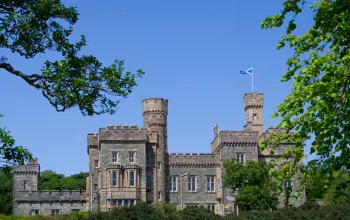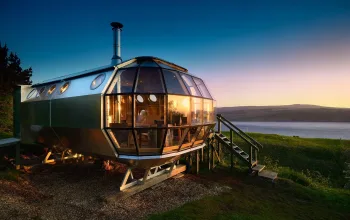LAIRIG LEACACH
Lairig Leacach, the ‘pass of the flagstones’ is a very handy place to know. Found in a tight V-shaped cleft between the Grey Corries and the Easians, on the high point an old droving road that used to run from Great Glen to the Kingshouse, the bothy is surrounded by high peaks that cannot help but whet your appetite.

Consequently, the shelter is very popular. A bunk-bed platform, sleeping 8 at a push, dominates the interior and there is also limited space on the floor to accommodate latecomers. There have even been rare incidents when the bothy has been deemed ‘full’, and people directed on to Meanach or Staoineag further south.
Although this is strictly against the MBA code, come prepared with a tent, although there is limited potential to camp close to the shelter. Inside there is a long shelf for cooking on and a petite Dowling stove.
SIZE: Small; bunk-bed sleeping platform for 8
LOCATION: Central Highlands - LAT/LONG 56.8227, -4.8158, NN 283 736, 467m, LR Map 41
PARKING: By the old tramway (NN 256 788) OR at Corrour station (NN 356 664)
KEY ATTRACTIONS:
- Munro baggers are spoilt for choice. Both Stob Ban (981m) and the Easians, Stob Coire Easain (1115m) and Stob a’ Choire Mheadhoin (1105m), are straight out of the door while the Grey Corries ridge is further west.

SHENAVALL
A flagship MBA bothy, Shenavall is one of the best-known and busiest in Scotland, and a visit is the perfect introduction to the delights of bothying. Spectacularly located on the edge of the Fisherfield Forest and close to an area of remote peaks described by Alfred Wainwright as ‘the Great Wilderness’, it has been a magnet for Munro baggers and walkers for over a century.
You can read a wealth of background material from accounts by the people who lived there, to entries in journals and bothy books, including vivid passages in Ken Wilson and Richard Gilbert’s classics, The Big Walks and Wild Walks. Renowned author and mountaineer WH Murray visited in the 1950s, and HRH Prince Charles also hiked out here while still a pupil at Gordonstoun.
Unless you are visiting out of season you are unlikely to have the place to yourself, but this region is one of the jewels of the Scottish Highlands and an opportunity not to be missed. Shenavall derives from the Gaelic seann bhaile meaning old town, and possibly refers to an earlier township in the glen Strath na Sealga before the Clearances.
The bothy, constructed in 1891, was one of the first to be taken on by the MBA in 1966, and had an original layout comprising of 3 equal-sized rooms on the ground floor and stairs up to a large attic. Additional outbuildings were demolished after a storm in the early 1990s, though the partly ruined byre to the South remains.
Over the years the bothy’s popularity had taken its toll on the fabric of the interior, but during 2013 and 2014 MBA work parties completed major renovations. They extended the ground-floor LHR towards the stairs to make a larger communal area, and demolished the rotting annexe, adding a window in the reconstructed stone work.
SIZE: Large; plenty of sleeping space
LOCATION: Northern Highlands - LAT/LONG 57.7768, -5.2541, NH 066 810, 128m, LR Map 19
PARKING: Car park Corrie Hallie (NH 114 850)
KEY ATTRACTIONS:
- Perfect base to tackle the ‘Fisherfield Six’, comprising 5 remote Munros – Ruadh Stac Mòr (919m), A’ Maighdean (967m) Beinn Tarsuinn (937m), Mullach Coire Mhic Fhearchair (1018m) and Sgurr Ban (989m) – plus Beinn a’ Chlaidheimh (914m), now downgraded to a Corbett.
- Other superlative days out include climbing Corbett Beinn Dearg Mòr (910m) viewed from the bothy door, and the iconic ridge of An Tealleach to the North.

CORROUR
Standing resolute beneath the steep slabs of The Devil’s Point in the strath of the meandering River Dee, Corrour Bothy is one of the most famous and popular of all Scotland’s open shelters. Over the best part of a hundred years, it has been a refuge for generations of hill-walkers and climbers, and is referenced in numerous dispatches, articles and books such as Gordon Seton’s The Charm of the Hills and Adam Watson’s It’s a Fine Day for the Hill.
Consequently, the bothy can be busy during the summer months so it is best to take a tent, especially at weekends. But in the quieter winter months, the shelter really comes into its own and if you are prepared to venture out here under a covering of snow, the true sense of the majesty of the Cairngorms’ inner sanctum reveals itself.
The bothy is a simple granite dwelling, built in the latter part of the 1870s as a deer-watcher’s hut – one of a number on the Mar Lodge Estate. In the 1920s the estate closed the hut, but the lock was soon forced, and it became well known as an unofficial ‘open’ bothy.
Over the years the wooden internal fixtures were stripped out and burnt, and the external stonework slowly deteriorated. It was only through the initiative of members of the Cairngorm Club in 1949 that it was rescued from total ruin, after they made a successful public appeal for funds. After the MBA took over maintenance in the late 1960s, the bothy remained a simple shelter until major renovation over 2006-7 transformed it into a snug, comfortable abode.
An enclosed porch opens into a single room with a small sleeping platform in an alcove to the left of the entrance and a fireplace. The platform can comfortably sleep 2 people with space below it for 2 more. A wooden floor, panelling and insulation has made the bothy cosier and the whitewashed stonework on the hearth wall reflects more light.
SIZE: Small; single room with sleeping platform for 3
LOCATION: Eastern Highlands - LAT/LONG 57.0418, -3.6810, NO 981 958, 564m, LR Map 36
PARKING: Linn of Dee car park (NO 063898) OR at the Lower Cairngorm Ski Centre car park ‘The Sugar Bowl’ (NH 985 074)
KEY ATTRACTIONS:
- Wonderful walking country. The round of Munros to the West: The Devils Point (1004m), Cairn Toul (1291m) and Braeriach (1296m) is a classic outing, while a longer trek brings you to Beinn Bhotair (1157m) and Monadh Mòr (1113m).
- A wander up to the Lairig Ghru and Pools of Dee, or round to Garbh Choire refuge are good wet weather options.

CAMBAN
Camban sits high up on the long, lonely pass that links Glen Affric and Glen Lichd, close to the watershed west to Loch Duich, and east through to the Beauly Firth. The name is composed of two elements in Scots Gaelic: camas (a bend in a river) and bàn (probably ‘fair’, a reference to the area’s light-coloured vegetation).
It was once a staging post on an old droving road through from Skye and the Northwest to the livestock markets in Dingwall and Inverness, but fell out of use in the early 1800s when the new estate owners introduced sheep to graze the land. The cottage was built around this time to house a shepherd and his family, and there are census records going back to the 1830s listing the various occupants.
The last tenant, named Paterson, finally moved down the glen between 1917 and 1920 and settled at Alltbeithe, now a youth hostel. Camban was then closed up, but over the years functioned as a rough-and-ready shelter, providing useful refuge in this remote mountain terrain.
However, by the 1960s, like so many of these remote outposts, the structure was in a quite ruinous state, and it was only through the initiative of two families who wanted to create a memorial to their lost sons, Philip Tranter and Alistair Park, that new life was breathed into the place. In 1966 these two experienced mountaineering friends died in separate climbing accidents and the families wanted to set up a mountain refuge as a fitting tribute.
In 2008, when a second, more extensive renovation took place, a new roof was installed and sleeping platforms built to replace the original loft space. The entrance to the bothy opens into a long hallway with doors right and left leading into 2 spacious, equal-sized rooms. Each has a working fireplace, and bunks along the back wall. There is no further insulation in the building and the interior stonework is exposed, making for a rustic stay!
SIZE: Medium; 2 rooms both with large sleeping platforms
LOCATION: North West Highlands - LAT/LONG 57.2143, -5.2250, NH 053 184, 279m, LR Map 33
PARKING: By the Mountain Rescue Post at Morvich (NG 960210) OR in the layby on the A87, 1 mile east of the Cluanie Inn (NH 091 121)
KEY ATTRACTIONS:
- Fantastic location to tackle the surrounding Munros: to the W is Ben Fhada, also known as Ben Attow (1032m) and to the S Ciste Dhubh (979m), Aonach Meadhoin (1001m) and Sgùrr á Bhealaich Dheirg (1036m), along with the prominent Sgùrr an Fhuarail (987m).

SOURLIES
Tucked into the hillside, Sourlies sits on the edge of a grassy field above the stone beach and mudflats at the head of Loch Nevis. After the hard-earned walk in, there is a real sense of satisfaction as you soak in the stunning fjord-like landscape reminiscent of Norway or New Zealand.
Unfortunately, over recent years the shelter has gained in popularity, perhaps a little to its cost. There are few days in the summer months when a tent is not pitched within view of the bothy door, and the accumulation of rubbish is a continual problem. Although you are unlikely to get the place to yourself, Sourlies’ particular brand of west-coast magic is irresistible and will draw you in time and again. Try to visit out of season, when spending time here feels like a real privilege.
Recorded history of the area dates back to the 1750s, and evidence of habitation is clear from the ruined farmsteads, rusting fence posts, and cleared areas. The once orderly landscape of hayfields and neat ridgeand- furrow beds of corn, potatoes and oats is reflected in the Gaelic name, which suggests an enclosed garden in a swampy place.
Once the byre to the original croft – the ruin sits near by – the bothy comprises a single, low-slung room with an open hearth at one end and a sleeping platform at the other, accommodating 6 people at a squeeze. Another sleeping platform runs along the length of the far wall, fashioned into a bunk bed at the fireplace end. This doubles up as seating if the bothy is not too crowded. Light is provided by 2 transparent roofing panels, and a small window at the west gable end, as well as perspex window panes in the door frames.
The fireplace has a reputation for being very smoky so lay your fire as far back as possible. The bothy’s construction was part-funded by the Scottish Rights of Way Society, which also raised money to repair the Allt Coire na Ciche bridge, a once notorious river crossing ½ mile above the bothy.
SIZE: Small; single room with raised platforms, sleeping 8
LOCATION: Western Highlands - LAT/LONG 56.9974, -5.5127, NM 869 951, 24m, LR Map 33/40
PARKING: Inverie pier (NG 764 001) OR at Loch Arkaig, Strathan (NM 987 916)
KEY ATTRACTIONS:
- Munro and Corbett-baggers can choose from Sgùrr a Ciche (1040m), Garbh Choire Mhor (1013m) to E, Meall Buidhe (946m), Liunne Bheinn ((939m) and Beinn an Aodainn (887m) to the North, and Bidein à Chabair (867m) to the South.
- Stop at the Forge in Inverie, the UK’s most remote mainland pub.
- Spectacular trip by kayak up Loch Nevis from Inverie.
The Scottish Bothy Bible, published by Wild Things Publishing, is the first ever complete guide to Scotland's bothies. The book is written by Geoff Allan, a man who has hiked and biked to every wellknown Scottish bothy. An artist, photographer and surveyor, he is also a maintenance officer for Dibidil – a Mountain Bothy Association’s bothy on the Isle of Rùm – and your perfect guide to exploring Scotland’s wild places.
For more information about these wonderful bothies and to discover loads of the other hidden gem shelters in Scotland, get your copy of The Scottish Bothy Bible now.






















